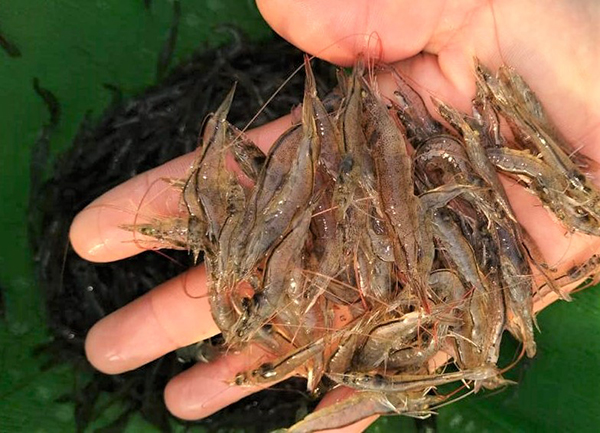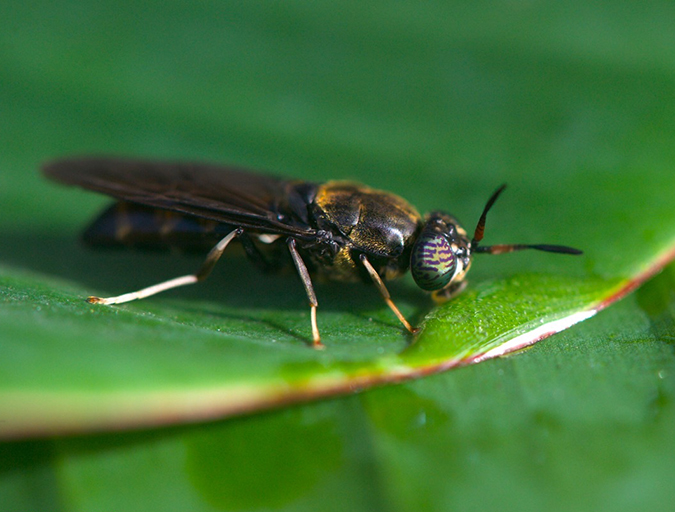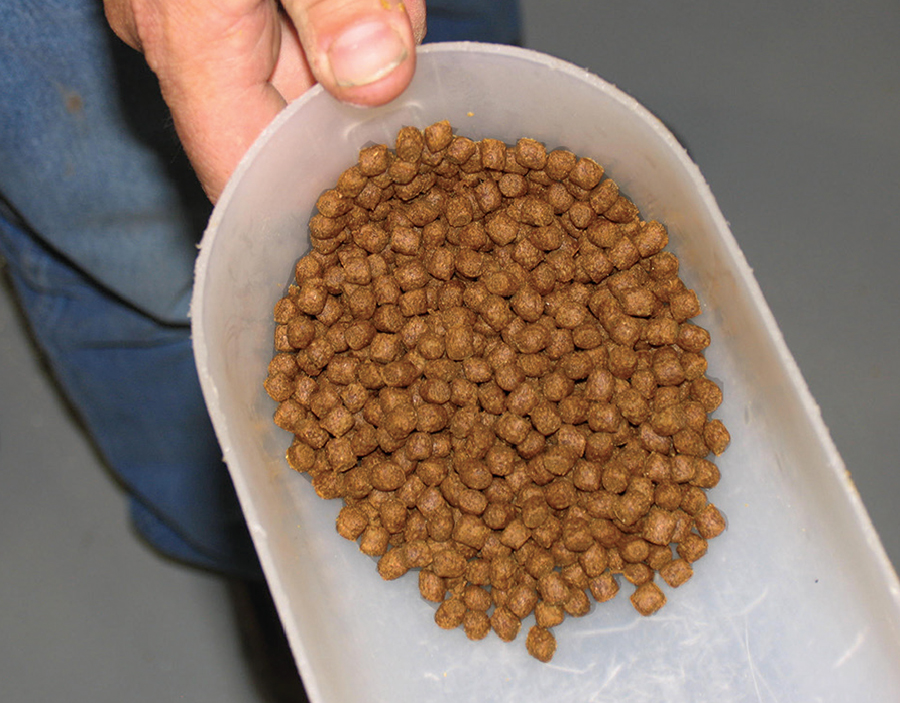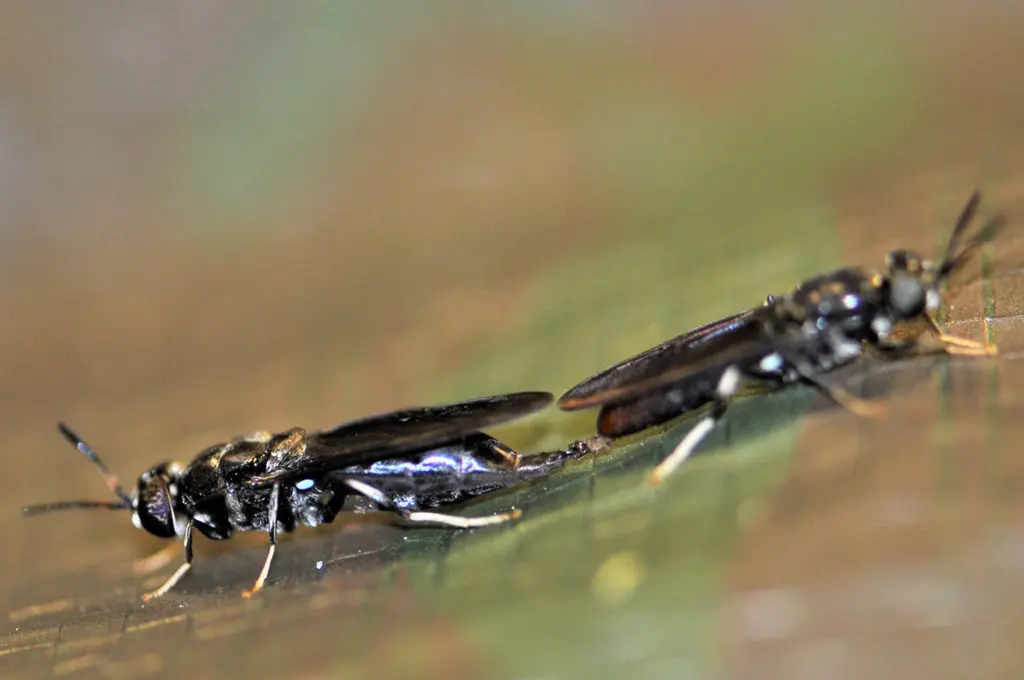Results show dietary supplementation can improve growth, feed utilization and immune responses in L. vannamei

Insect meals have recently become an attractive alternative protein source for the production of sustainable aquaculture feeds. In addition to their high protein levels, insects are also rich in lipids, minerals and vitamins that support growth of shrimp and fish. Insect larvae can rapidly convert low-quality organic wastes into high-quality fertilizer or growth promoters in animal feeds and several species of insects have been found to possess antifungal and antibacterial properties. The protein content of insects ranges from 50 percent to 82 percent (dry matter basis) depending on the insect species and/or their processing method.
Compared to most protein sources, insects farmed under controlled conditions could be a more viable protein source than fishmeal in aquaculture feeds. Insects are rich in essential amino acids (AAs) making them highly desirable as an excellent protein source for aquaculture. Many insects have been reported to contain considerable amounts of the AAs taurine and hydroxyproline, both of which are lacking in plant protein sources. Therefore, insect meals can be a promising protein source aquafeed production. Several insect species used in fish feeds have also been reported to improve the immune response, antioxidant activity and disease resistance of aquatic animals. But very few studies have assessed the benefits of using insect meals as a protein source for shrimps.
There are over 1 million known insect species worldwide; insects represent the largest and most diverse group within the Arthropoda phylum, but only a few species have been used for commercial purposes. The dynastid beetle (DB, Allomyrina dichotoma) is widely used as a traditional medicine to treat many diseases. The rice grasshopper (RG, Oxya chinensis) has long been used as a food source in Asia. The black soldier fly (BSF, Hermetia illucens) is prominent among new ingredient candidates and its larvae can consume materials such as food wastes and agricultural byproducts. The white-spotted flower chafer (WFC, Protaetia brevitarsis) has also been used in traditional East Asian medicine due to its excellent antithrombotic activity. The mealworm (MW, Tenebrio molitor) is commonly found in agricultural products and is considered the most promising species for commercial production and industrial applications. The two-spotted cricket (TSC, Gryllus bimaculatus) also has a long history of traditional use in oriental medicine. The silkworm (SW, Bombyx mori) has long been reared worldwide for the production of silk and is currently used for the commercial production of medical or industrial biomaterials through genetic engineering.
Estimating the digestibility of a particular feed ingredient is the first step toward determining whether the ingredients in question can be used safely in fish and shrimp feeds. The Pacific white shrimp (Litopenaeus vannamei) is the most widely cultured shrimp species, but to the best of our knowledge, very few studies have evaluated the digestibility of insect meals for L. vannamei culture.
This article – adapted and summarized from the original publication [Shin J. and K.J. Lee. 2021. Digestibility of insect meals for Pacific white shrimp (Litopenaeus vannamei) and their performance for growth, feed utilization and immune responses. PLoS ONE 16(11): e0260305] – examined the potential use of the above-described insects as protein sources for L. vannamei feed by evaluating their digestibility after which we conducted a feeding trial.
Study setup
For the digestibility test of the seven insect meals tested in this study (sourced from local commercial suppliers), a reference diet was formulated using tuna byproduct meal (TM) and soybean meal as the major protein sources. Shrimp postlarvae were procured from a local shrimp hatchery (Tamra Shrimp, Jeju, Korea) and reared until they reached the desired size. Then, a total of 264 shrimp (body weight: 5.15 ± 0.5 grams) were distributed into eight 240-liter acrylic tanks.
The animals were fed a reference diet for six days to be acclimated to the diets and tanks before the fecal collection for the digestibility. The average water temperature and dissolved oxygen (DO) were 27.8 ± 1.25 degrees-C and 5.04 ± 0.36 mg/L, respectively. Shrimp in each tank were fed one of the test diets twice daily at 3 to 4 percent body mass. Uneaten diet and fecal residues in each tank were siphoned after each feeding, and feces samples were collected for various analyses.
For the feeding trial, a control diet was formulated using 27 percent tuna byproduct meal as a fish meal source and seven other diets were prepared replacing 10 percent tuna byproduct meal in the control diet with each insect meal. Triplicate groups of shrimp (initial body weight: 0.17 grams) were fed the diets for 65 days, and then data collected to determine various parameters, including final body weights, growth rates, FCR, survival and others. Tissue samples were also collected for various lab analyses.
For detailed information on the experimental design and animal husbandry; preparation of all diets; digestibility and feeding trials; and sampling and analyses, refer to the original publication.
Results and discussion
This study was the first to determine the digestibility of various insect meals for the production of shrimp feeds. The apparent digestibility coefficient (ADC) of the tested insect meals was 83–89 percent for protein, 91–98 percent for lipid, 84–90 percent for energy, 77–81 percent for dry matter, 76–96 percent for AAs and 89–98 percent for fatty acids. Other researchers have reported that the ADC of MW in L. vannamei was 76.1 percent for protein, 66.5 percent for energy, 45.9 percent for dry matter and 72–86 percent for AAs, showing relatively low values compared to our results.
In our study, DB had the highest protein, lipid and energy ADC in L. vannamei (84–92 percent, 92 percent and 87–97 percent, respectively). Furthermore, lipid ADC of the tested insect meals was relatively higher than those obtained from FM in previous studies. The availability of lysine and methionine, the two most limiting AAs in the plant protein sources, of the tested insect meals, were 90–95 percent and 87–93 percent, respectively, which was consistent with previous studies where lysine and methionine availability of FM were ranged 92.0–92.7 percent and 93.9–94.7 percent, respectively. Interestingly, all the tested insect meals had very high availability of taurine, which could be another advantage of using the insect meals in shrimp feeds. The insect meals evaluated in this study exhibited better digestibility than other previously reported protein sources. Overall, our findings indicated that insect meals can be used as highly digestible protein sources in shrimp feed.
Our data for digestibility of chitin [a bioactive compound and a major constituent of insect exoskeletons] of the tested insect meals was relatively lower (28–36 percent) compared to other nutrients. Other researchers have reported that dietary insect chitin could partly be digested by L. vannamei, and that insect chitin is likely to contribute directly or indirectly to the immune responses of the shrimp. Nonetheless, dietary chitin levels should be carefully optimized, as excessive dietary chitin supplementation (>10 percent) has been reported to reduce growth, feed utilization, and protein and lipid digestibility in black tiger shrimp (Penaeus monodon).
In the feeding trial, dietary replacement of 17 percent fishmeal with each insect meal did not show any significantly reduced growth or feed utilization of L. vannamei. On the contrary, the insect meal inclusions (or replacement of fishmeal) in the diets improved the growth performance of the shrimp. Other authors have examined the dietary utilization of BSF for L. vannamei (1.2–16 grams) and reported that BSF can replace 25 percent fishmeal without any negative effect; that L. vannamei fed a diet in which 50 percent fishmeal was replaced with a defatted MW had significantly higher weight gain and lower FCR than a control group (no replacement); and that insects have great potential as a protein source in fish feeds due to their good AA profiles and high levels of taurine and hydroxyproline compared to most plant protein sources. Other research also indicated that intestinal microbial communities, anti-inflammatory factors and digestive enzyme activity of fishes could be enhanced by the inclusion of insect proteins in their diets.
In our study, the tested insect meals appeared to meet all the nutritional requirements of L. vannamei, at least at the tested fishmeal replacement levels. More importantly, the proximate composition of the whole-body shrimp was not influenced by the inclusion of the tested insect meals, which are consistent with previous studies on SW or BSF. But in contrast, other researchers have reported that feeding L. vannamei with non-defatted MW increased their whole-body lipid content. These discrepancies may be due to variations in the nutrient contents of the insect meals as well as processing methods and life cycle stage of the insects and their dietary formulations.
Our findings also revealed that dietary supplementation of the tested insect meals can improve the innate immune responses and antioxidant enzyme activities of L. vannamei. Insects are known to contain a variety of antimicrobial compounds [antimicrobial peptides, AMPs] which possess several health-promoting properties including antibiotic activity. Therefore, the AMPs present in the tested insect meals could explain the enhanced innate immunity and antioxidant enzyme activity of the shrimp in our study. A study is needed to confirm the effects of dietary supplementation of insect AMPs on shrimp immune responses and physiological activities.
Dietary inclusion of the tested insect meals also affected fatty acid composition of the shrimp muscle, which mirrored the fatty acid composition of the diets. The fatty acid profiles of the tested insect meals exhibited relatively high levels of monounsaturated fatty acids, MUFA and polyunsaturated fatty acids, and low levels or a lack of highly unsaturated, omega-3 fatty acids (docosahexaenoic acid, DHA; and eicosapentaenoic acid, EPA) compared with fishmeal. Many studies have reported that dietary inclusion of insect meals increases MUFA concentration and decreases highly unsaturated fatty acids (DHA and EPA) levels in muscle of shrimp and fish.
Terrestrial insects lack DHA and EPA, but the fatty acid composition of insects can be affected by the nutrient contents of their feeds during their growing stages, as reported by various researchers. Therefore, the fatty acid profiles of insects are thought to be easily modified, which is another benefit of using insect proteins in aquaculture feeds. And the oil fraction and bioactive compounds in BSF could be a reason for the enhanced shrimp growth and immune responses observed in this study.
Perspectives
Our results demonstrate the applicability of the tested insect meals as protein sources for L. vannamei feed. Dietary supplementation or fishmeal replacement with the tested insect meals could improve the innate immunity and antioxidant capacity of the shrimp. However, further studies are needed to characterize the properties of the bioactive compounds contained in the insect meals and to assess their effects and safety.
Now that you've reached the end of the article ...
… please consider supporting GSA’s mission to advance responsible seafood practices through education, advocacy and third-party assurances. The Advocate aims to document the evolution of responsible seafood practices and share the expansive knowledge of our vast network of contributors.
By becoming a Global Seafood Alliance member, you’re ensuring that all of the pre-competitive work we do through member benefits, resources and events can continue. Individual membership costs just $50 a year.
Not a GSA member? Join us.
Authors
-
Jaehyeong Shin, Ph.D.
Department of Marine Life Science, Jeju National University, Jeju-si, Jeju Self-Governing Province, South Korea
-
Kyeong-Jun Lee, Ph.D.
Corresponding author
Department of Marine Life Science, Jeju National University, Jeju-si, Jeju Self-Governing Province, South Korea, Marine Science Institute, Jeju National University, Jeju-si, Jeju Self-Governing Province, South Korea
Tagged With
Related Posts

Responsibility
‘Do more and do better’ – Sustainability manager discusses Skretting’s ambitious agenda
Aquafeed giant Skretting recently appointed Jorge Diaz as its sustainability manager to advance its ambitious sustainability agenda.

Aquafeeds
Buggin’ out: Tapping the potential of insect meal in aquaculture
Black soldier flies are gaining interest as a leading alternative ingredient in aquafeeds. But will the “ick” factor be a turn-off? Advocate contributor Clare Leschin-Hoar investigates.

Aquafeeds
Insect meals: Novel protein, fat sources for farmed shrimp
Poor-quality ingredients can’t become good-quality ingredients. Quality protein is essential for the healthy growth of any omnivorous or carnivorous aquaculture species. Insect meals seem to fill this need, and their mass-scale production appears to be sustainable.

Aquafeeds
Black soldier fly larval production in a stacked production system
Study describes development and evaluation of an “all-in-one” stacked system for indoor production of black soldier fly larvae.



